WebRTC is… everywhere.

WebRTC started some 6 years ago. It was just another VoIP protocol specification that just happened to be targeted at browsers.
Six years in, and now WebRTC is everywhere. There are still those who believe it has failed, or haven’t lived up to its expectations. I’d say it is the vendors who failed to adopt it are the ones that have failed.
See also: WebRTC Application
How do I know?
It has to do with those that are using it. Here are 10 massive applications that are making use of WebRTC. These companies trust WebRTC to offer them the leverage they need to deliver the user experience they strive for.
Looking for more vendors using WebRTC? Here are 10 interviews with inspiring vendors using WebRTC.
What’s Massive in WebRTC Land?
Before we start though, I want to say a word about what massive is.
It is really hard to know what’s massive. How do you count it? Especially when none of the vendors are willing to share their numbers in meaningful ways here.
So let’s do a back-of-the-napkin kind of calculation here for a sec –
In the recent Kranky Geek event, Google shared in their session an interesting statistic:
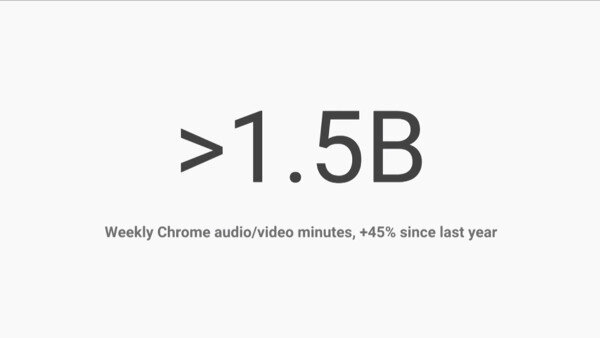
Over 1.5 billion of weekly audio/video minutes.
That’s easily upwards of 214 million minutes a day.
And that’s only on Chrome.
This number doesn’t include:
- Other browsers. Today that means Firefox, Edge and Safari
- Usage through plugins. Which covers Internet Explorer
- Electron and CEF based applications. And there are a few very popular ones I can think of
- Mobile applications, making use of WebRTC
- Those who take the bits and pieces of WebRTC that they need, integrate it with their service, and then just make use of it (not always with proper attribution)
So the numbers are larger. Much larger.
The Google Machine and its Leftovers
Back to that more than 214 million minutes a day.
During March 2017, Serge Lachapelle, the person in charge of WebRTC in the past and now of Google Hangouts and Meet, shared some numbers about video conferencing at Google during Google Cloud Next 2017:
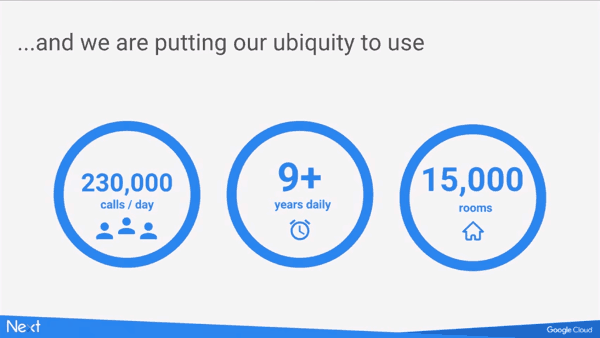
9+ years daily translates to over 4.7 + minutes daily.
That’s the amount of use Google makes internally of Hangouts.
It is safe to assume that external use of non-Googlers can double that number with little effort to over 9 million minutes a day.
And continuing this lenient calculation, Hangouts accounts for 4-5% of all voice and video traffic in WebRTC.
Consider here fact that I counted Hangouts over multiple devices, browsers and applications while comparing it to Chrome only numbers, so I am fudging here a bit. On the other hand, I took non-Googlers to account for only half the usage, which is probably way too little.
Anyways, let’s look at them 10 massive applications who are already using WebRTC.
1. Google Meet and Google Hangouts
9+ years daily. Inside Google alone.
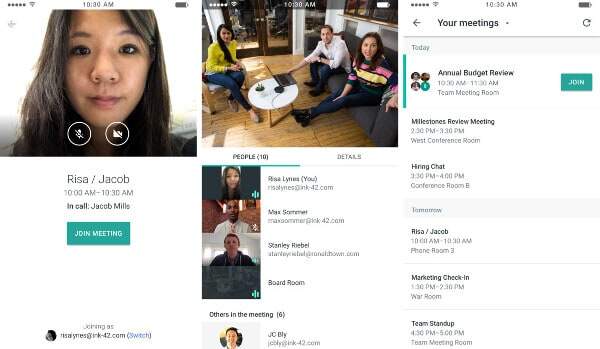
Google Meet (or more accurately, Hangouts) is most probably one of the main reasons we have WebRTC.
Google had their own video conferencing service, working from Gmail, but it needed a plugin. Real time video just wasn’t there in the browser, which is where and why WebRTC started. And it started with a contribution by Google which we now know as webrtc.org.
To date, Google Meet (or Hangouts), is a massive application that makes use of WebRTC.
2. Facebook Messenger

Here’s something I wrote some 5 years ago. It is about Skype vs Facebook. Here’s how I phrased it then:
Facebook can adopt WebRTC and provide a calling experience that surpasses most VoIP players.
The rest of the analysis then is kinda funny. Facebook did end up adopting WebRTC wholeheartedly into Messenger, but none of my suggestions were implemented (which in hindsight was probably for the best).
Here’s where Facebook have integrated WebRTC already:
- Messenger – video chat and group video chat, mobile and browser
- Facebook Live – when co-broadcasting
- VR Chat – video calls in Oculus
- Then there’s Workplace by Facebook and Instagram Live Video Chat
All using WebRTC. I am even ignoring WhatsApp here (not sure what parts of WebRTC they use exactly).
At the recent Kranky Geek, we had Li-Tal Mashiach of Facebook talk about what it is they are doing with WebRTC and how do they scale their service.
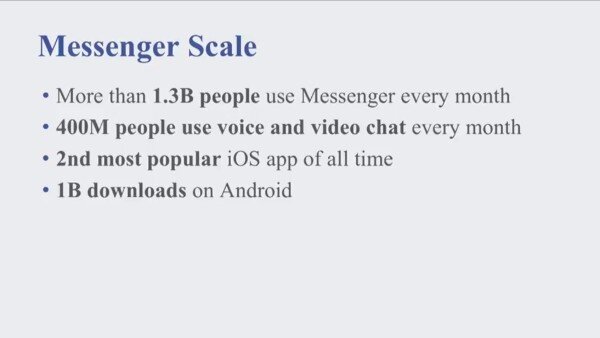
No minutes here, but 400 million people using WebRTC every month. That’s 13+ million people a day on average. With only a minute each this is already massive.
3. Discord
I came across Discord and its use of WebRTC in July 2016, through a message I saw on Facebook somewhere. As any other vendor that gets into my radar, I continued to follow them closely.
Discord is a social platform for gamers (for lack of a better term). They have been around for only 2.5 years. This month, they shared a few numbers. Specifically:
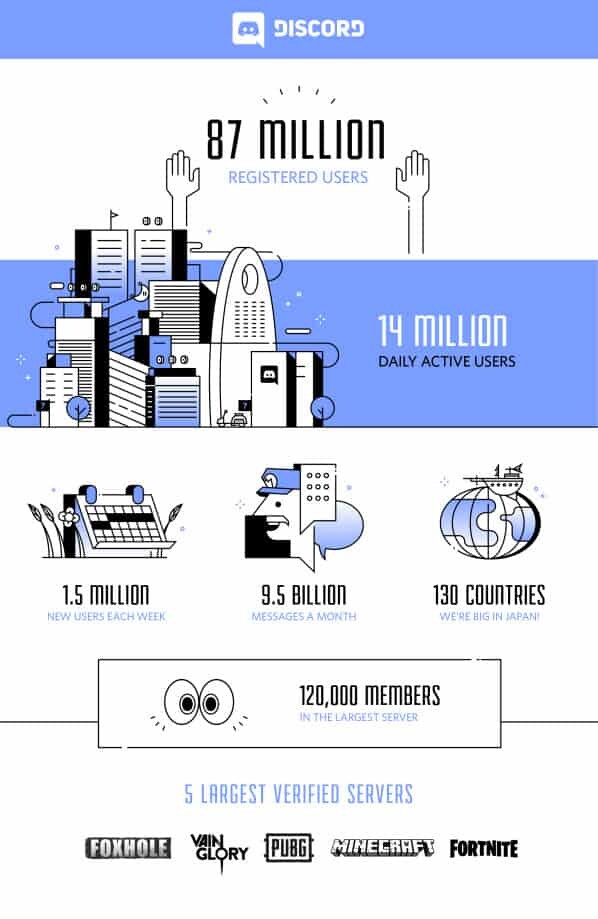
Nothing here about voice and video, but I do know that the numbers here are impressive.
4. Amazon Chime
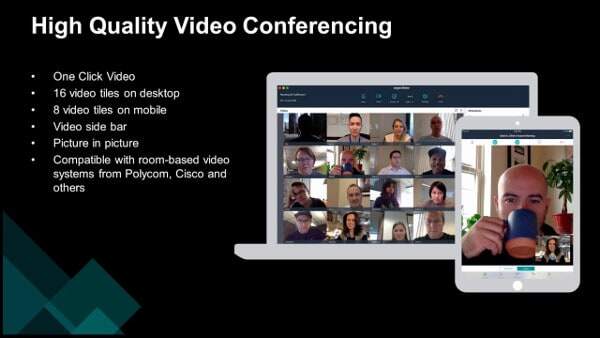
Amazon Chime is new to the scene of unified communications and already big.
Chime started as an acquisition only a year ago of a company called Biba. It was probably already well underway to become a replacement for Amazon’s own internal video conferencing services. At Amazon’s re:invent event last month, Amazon shared a few numbers of how they use Chime internally:

24.8 million minutes a month. That’s almost a million minutes a day. From Amazon’s internal meetings only. Not including any of their Chime customers.
Not as massive as the others, but still quite large.
One thing to note – this isn’t “pure” WebRTC. Amazon took the approach of supporting legacy video conferencing systems first, so they “did” something to WebRTC to make it work. Their roadmap for next year is to add direct browser for users as well. What we do know, is that this uses WebRTC technologies inside today already.
Oh… and I didn’t even mention Amazon Connect, Alexa and Mayday – all making use of WebRTC.
5. Houseparty

Houseparty is huge. Especially if you’re a teen. My daughter will probably start using it in a few years… once she grows out of Whatsapp and Musical.ly. Or so I’ve been told.
Houseparty makes use of WebRTC, although it is a mobile only service.
There’s not much numbers going on about Houseparty this year, so I’ll stick to the ones we know from a year ago.
20 million minutes a day.
Enough said.
6. Appear.in
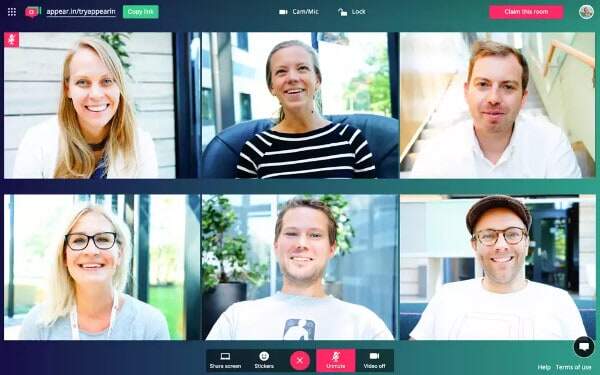
Appear.in started as a summer internship project at Telenor Digital somewhere, growing up to this point in time. Today it got acquired by Videonor.
The service is a favorite of many in the WebRTC community (and elsewhere – they are doing millions of minutes a day).
If you haven’t tried it yet, then you should: appear.in
And yes. It is in the league of the other vendors here when it comes to size.
7. Gotomeeting

There are many traditional VoIP (interesting that VoIP can now be considered traditional) that have started adding WebRTC to their offerings.
Most can probably make it into this list of massive applications.
Out of them, I decided to choose GoToMeeting. Why? Because the integration they’ve done was quite a natural one. I’ve been using it for well over a year now whenever someone invited me into a meeting over GoToMeeting – in most cases, they weren’t even aware of the browser option.
8. Peer5
I wanted to add a company that doesn’t do voice and video. Or rather ones that are making use of the WebRTC’s data channel.
The one I picked here was Peer5. It was the easiest for me to get numbers from (I am an advisor there).
The P2P CDN scene is getting quite interesting lately. Alongside the startups like Peer5 that are pushing the envelope we now see companies like Akamai who stated publicly that they are headed this way with WebRTC as well.
In this year’s Kranky Geek event, Hadar Weiss, Co-founder and CEO of Peer5, shared a few of their numbers:
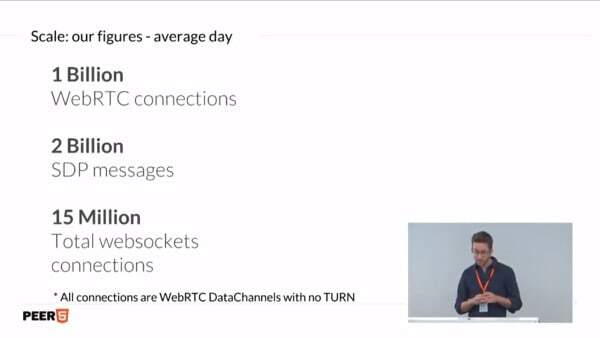
1 billion connections a day is large. Compared to millions of minutes a day. But we have to remember – a lot of these connections are short-lived in nature (viewers reaching out to peers they might stream data from or to) and that the more interesting number, which isn’t publicly available yet, is about actual data traffic.
9. CPaaS vendors
CPaaS vendors drive this industry forwards. They do so for the smaller vendors as well as the largest ones.
Need examples?
In 2016, Twilio claimed to process “more than a billion minutes of WebRTC calls made through Twilio” as part of their launch of Voice Insights.
TokBox has stated this year that they power social video apps including Monkey, Houseparty, Fam and live.ly.
And they are not alone with it. There are 20+ such vendors catering to the needs of other developers.
Some of the CPaaS vendors can definitely be considered massive when it comes to the WebRTC traffic they generate.
10. Back to you now
I most definitely forgot a vendor or two here.
Scroll down and comment below with your 10th candidate for the massive application using WebRTC.
WebRTC is Still Miniscule
Let’s look at some other engagement metrics out there.
Netflix shared their numbers for the year this month:
Netflix members around the world watched more than 140 million hours per day
Hours. Not minutes. In minutes? That’s 8.4 billion minutes a day. For a single vendor. Compared to WebRTC’s 214 million minutes a day on Chrome.
I’d say WebRTC has room to grow.
Here’s for a bigger 2018.
Looking for more vendors using WebRTC? Here are 10 interviews with inspiring vendors using WebRTC.

Slack (uses Janus as its SFU I believe).
Dean,
That’s correct, though it is changing. Slack are now working on their own self-developed SFU. They shared the reasoning in a recent Kranky Geek event: https://www.youtube.com/watch?v=VJj4ddWDTbs
We are a startup company, and developing video platform. This article is very informative and good enough for anyone to understand where WebRTC can go. Great work.
Please look at Temasys.io
Bill Lewis
Co Founder
Wire.com has been built around WebRTC. Founded by Jaanus Frise of Skype fame and Alan Duric is CTO. Currently they are looking for additional developers and marketing personnel.
Wire is totally cross-platform: iOS, Windows 10, Mac OS/X and web browser. Also messages are fully encrypted end-to-end.
Thanks Jim.
I am not sure how big they are in terms of actual traffic. There are now over 1400 vendors and projects that I am tracking around WebRTC. Wire is one of them.
I tried in this article to capture those that are seeing massive amounts of traffic over their WebRTC infrastructure.
jitsi meet becomes big now in altasian
Jitsi itself is a very popular open source project of a WebRTC based SFU.
I wouldn’t be surprised if some of the services I listed in this article are using it themselves.
twinme private messenger & voice/video calls is a mobile app (iOS & Android) using WebRTC for voice/video calls, but also for exchanging messages and contents (photos, voice messages, etc.) in P2P using the data channel, without store & forward servers in between. This enables unique new services such as listening to music recorded on your device together with your friend while chatting. P2P group conversations will be coming soon in 2018.
Over 300 K users worldwide at this time, without any advertising.
A sister app called Skred was launched end of September 2017 by the Skyrock media group targeting the 15-25 urban youth, with over 70K new users in 2 month.
Michel, thanks for sharing – good luck with making Skred a success!
How about testrtc – what are your numbers?
Not in the millions obviously 🙂
We are a testing service and we do see surge in traffic when our customers run large stress test scenarios.
i notice webex now supports browser without a plugin – are they using webrtc?
Yes they do, but not for the whole service yet.
I think screen sharing isn’t supported for the sharer in WebRTC at the moment.
Great post Tsahi. Thanks fir your diligence reporting on, advising and evangelizing this technology. The companies and use cases confirm the value of WebRTC. We’re just getting started.
🙂 Thanks Mike
Good to see these numbers.
Wizix is a startup that has a product called gridMe which supports up to 9 people in a video session on iOS and Android. Sessions of up to 4 users use webRTC in a mesh. Its still early days for us but please check it out.
Thanks for the tip Philip – I’ve added it to my dataset of vendors 🙂
I would also mention the mizu webphone as the king of the standards based WebRTC clients. It works with any VoIP server such as Asterisk, based on SIP signaling over websocket protocol described in RFC 7118.
Thanks for sharing Laszlo
I have been following WebRTC from starting days and am using goconsult.in for my meetings (It’s an affordable alternative and a way simple than GoToMeeting).
WebRTC has one major problem.
It does not respect VPN’s.
In fact, it gives up the user’s actual IP while the user believes their anonymity is protected via their VPN.
Facebook just lost billions of dollars of valuation because they were sharing user data without explicit permission. And using that data to elect a president that the majority find abhorrent.
Not sure the two correlate this strongly…
Facebook’s use of the data is at the heart of their business model. The amount of data that they collect and share is huge. I’d also remind everyone that the previous president used data on Facebook and social networks to get elected – it might not have been that blatant, but it is kinda standard practices in the last 10 years at least.
WebRTC shares a user’s private IP address because that’s just how VoIP works – and it can’t really work well without it. That same private IP address is shared by most VoIP protocols to get calls connected directly. On top of that, IP addresses are quite static (mine is 10.0.0.4 at the moment if you really need to know) and their use for privacy reasons is bad practices – it won’t hold water when we all migrate to IPv6 anyway.
On top of that, assuming you are using a VPN, you can use the WebRTC Chrome Limiter extension and get that one sorted out for you as well.
http://ipop-project.org/
User-centric VPNs based on WebRTC
I’ve been doing voip products for over 10 years (I’ve built voip stacks used by verizon/vodaphone type of customers). Right now I’m leading effort to build voice enabled service for a company that has roughly 100M users and I expect within short amount of time we’ll have tens of millions minutes per day (right now our user use discord/houseparty/facetime/hangouts/skype). I’m curious if the metrics/stats include minutes of each participant in a group call? In there was 10 minute long call with 5 participants, does that add 10 minute or 50 minute to overall stats?
I don’t know, but my guess is that they count the minutes per participant separately.
I’m trying to add webRTC on my app but that’s a bit buggy using it with a webview (Android or IOs).
Jacques,
This is a question to ask on discuss-webrtc, preferably with a lot more details in it on what’s broken for you.
Hi, thank you for your answer.
I’ll try to express myself better, about my issues with WebRTC.
I’m trying to implement a web rtc solution on a mobile web app, basically it’s a my web app wrapped up in a container app within a webview. And web rtc doesn’t work in my webview (android or IOs) and i’ve searched on forums it say that it’s normal cause Web RTC is not supported by webviews, it’s sad cause that would open a range of possibility.
As for the web app part it work only on safari and Chrome but without sound or latency (the buggy part).
Finally I find that the technology could be better but their restraining it. Thats a waste of potential. (I hope i made my self clearer)
Not clearer by much, so really can’t be of help here – and again – discuss-webrtc is a better place for such things.
We use WebRTC for our atap2chat product here in the UK.
Thanks for sharing Fabio.
Hi Tsahi,
MyOwnConference (https://myownconference.com/) makes use of WebRTC. It’s webinar software.
Hello everyone,
Now webtalk https://www.webtalk.app is a good communicator in this segment! Built with WebRTC!
I have 10th application in the above list. The application named Thoodhan.
It also developed by the WebRTC.
Thanks for the information
We’ll be launching our live TV page on our social media website http://www.instarpop.com
Using webrtc
Helpful information, thanks.
2020 was a weird year, Because this year, teleconferencing has become more popular than ever.
Is there any fresh data about Netflix and webRTC daily usage for 2020?
Thanks in advance.
Numbers? I haven’t seen.
Closest is this (first few minutes): https://www.youtube.com/watch?v=-THOaymtjp8&ab_channel=KrankyGeek and my writing here: https://bloggeek.me/webrtc-growth-2020/